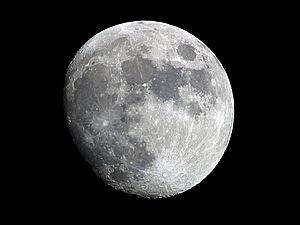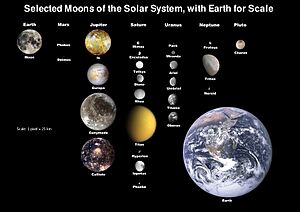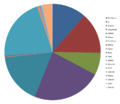Natural satellite facts for kids
A natural satellite is a smaller space object that travels around a larger one. It's held in its path, called an orbit, by the strong pull of gravity. When we talk about natural satellites, we usually mean moons that orbit planets. But the term can also describe small galaxies that orbit much bigger galaxies.
Objects that orbit planets are known as moons. They come in many different sizes. Our Earth has just one moon, which we call the Moon (with a capital 'M'). Some other planets have lots of moons, while a few have none at all. The word "lunar" comes from the Latin word luna, which means moon. So, when you hear "lunar eclipse," it's about an eclipse involving the Moon.
Anything that goes around a planet is a satellite. Moons are natural satellites because they form naturally in space. However, people also launch machines into space using rockets to orbit Earth. These human-made machines are called artificial satellites.
Contents
Our Earth's Moon: A Closer Look
Moons don't make their own light. We can see Earth's Moon because it acts like a giant mirror, reflecting the light from the Sun. The same side of the Moon always faces Earth, no matter where it is in its orbit. But because the Sun lights up different parts of the Moon as it moves, it looks different to us throughout the month. These changing appearances are called the phases of the Moon.
The Moon's cycle is how long it takes to go from looking full and bright to a tiny sliver, and then back to full again. For Earth's Moon, this takes about four weeks, or roughly 28 days. This happens about 13 times in one year.
A very important moment in history happened on July 20, 1969. That's when Neil Armstrong and Buzz Aldrin from the Apollo 11 mission became the first people to ever walk on the Moon.
How Moons Stay in Orbit
The path a moon or any other satellite takes, its orbit, is shaped by two main forces: gravity and something called centripetal force. For example, Earth's Moon stays in orbit because of the strong gravitational pull from Earth. This is similar to how Earth is pulled by the Sun and stays in its own orbit. The Moon's orbit around Earth actually causes the tides and waves in our oceans.
Can Moons Have Their Own Moons?
So far, scientists haven't found any moons that have their own smaller moons orbiting them. Usually, the strong gravitational pull from the main planet would make such an orbit very unstable. It would be hard for a "moon's moon" to stay in place.
However, some calculations suggest that if a moon had a ring system, like the possible rings around Saturn's moon Rhea, then smaller objects might be able to orbit within those rings. These rings are thought to be very narrow, which is often seen with "shepherd moons" that help keep rings in place.
Asteroids with Moons
In the early 1990s, scientists discovered that some asteroids have moons. The first proof came with the finding of 243 Ida's moon, Dactyl. Since then, we've found more, like 87 Sylvia, which actually has two moons! Some asteroids, such as 90 Antiope, are even "double asteroids," meaning they are made of two parts that are about the same size orbiting each other.
Major Moons in Our Solar System
The largest moons in our Solar System are those bigger than about 3,000 kilometers across. These include Earth's Moon, Jupiter's four big Galilean moons (Io, Europa, Ganymede, and Callisto), Saturn's giant moon Titan, and Neptune's captured moon Triton.
It's common for moons to be named after characters from mythology. The table below shows some of the moons in our solar system, grouped by their size. For comparison, some notable planets, dwarf planets, and asteroids are also included.
Planets with Natural Satellites
Here are the planets in our Solar System that have one or more moons:
Dwarf Planets with Natural Satellites
Even some dwarf planets have moons!
Planets Without Known Moons
Not all planets have moons. Here are the planets in our Solar System that don't have any known natural satellites:
Galaxies as Satellites
Galaxies are often found in groups called galaxy clusters. These clusters are also held together by gravity. Our own Milky Way galaxy is the second largest in our Local Group of galaxies. The biggest one is the Andromeda galaxy. Many smaller galaxies and star clusters are also part of our Local Group, orbiting either Andromeda or the Milky Way. Because of this, astronomers also use the term "satellite" for these smaller galaxies orbiting larger ones.
Our Local Group is just a small part of an even bigger collection of galaxies called the Virgo Supercluster. There are even larger groups of galaxies in the universe, like the Great Wall.
| The Solar System | |||||||
|---|---|---|---|---|---|---|---|
|
|
|||||||
| Sun • Heliosphere |
Planets ☾ = moon(s) ∅ = rings |
Mercury | Venus | Earth ☾ | Mars ☾ | ||
| Jupiter ☾ ∅ | Saturn ☾ ∅ | Uranus ☾ ∅ | Neptune ☾ ∅ | ||||
| Dwarf planets | Ceres | Pluto ☾ | Haumea ☾ | Makemake | |||
| Eris ☾ | |||||||
| Small Solar System bodies |
Asteroids (minor planets) |
Groups and families: Vulcanoids · Near-Earth asteroids · Asteroid belt Jupiter Trojans · Centaurs · Neptune Trojans · Asteroid moons · Meteoroids · Pallas · Juno · Vesta · Hygiea · Interamnia · Europa |
|||||
| See also the list of asteroids. | |||||||
| Trans- Neptunians |
Kuiper belt – Plutinos: Orcus · Ixion – Cubewanos: Varuna · Quaoar · Huya |
||||||
| Scattered disc: Sedna | |||||||
| Comets | Periodic comets and non-periodic comets Damocloids · Oort cloud |
||||||
| See also the list of solar system objects | |||||||
Images for kids
-
The relative masses of the natural satellites of the Solar System. Mimas, Enceladus, and Miranda are too small to be visible at this scale. All the irregularly shaped natural satellites, even added together, would also be too small to be visible.
See also
 In Spanish: Satélite natural para niños
In Spanish: Satélite natural para niños






